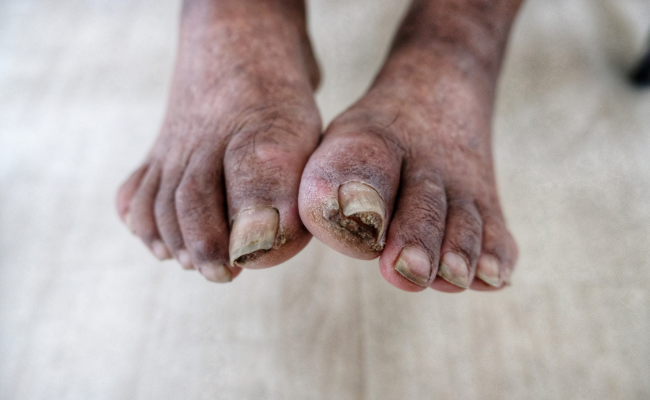How to Treat Gangrene?
- December 04, 2023
- No Comments

What is Gangrene?
Gangrene, a term rooted in the Greek word "gangraina," signifies the perilous state wherein body tissues succumb to death due to either a compromised blood supply or a bacterial infection. Manifesting in diverse forms, each presenting unique challenges and treatment considerations, gangrene primarily targets the extremities—fingers, toes, hands, and feet—although it has the potential to affect any part of the body.
This medical emergency, marked by the cessation of blood flow to a specific body part, results in the demise of tissues in that localized area. Typically originating in the extremities, such as the fingers, toes, hands, or feet, gangrene demands prompt and decisive intervention. Failure to address gangrene in a timely manner exposes individuals to a severe and potentially fatal threat, underscoring the urgency of recognizing and treating this condition.
Why does Gangrene occur?
- Gangrene arises from a compromised blood supply to a specific area of the body. This impairment can result from diverse factors, including traumatic injuries, infections, underlying health conditions like diabetes, atherosclerosis, or other circulatory disorders. The diminished blood flow deprives the affected tissue of vital oxygen and nutrients, leading to its necrosis and creating an environment conducive to bacterial growth.
- Infection plays a pivotal role in the progression of gangrene. When tissue dies, it becomes a breeding ground for bacteria, which can release toxins further damaging surrounding areas. The two primary categories of gangrene are dry and wet. Dry gangrene is characterized by a lack of infection, resulting in dry and shriveled tissue. Wet gangrene involves bacterial infection, leading to moist and swollen tissue. Gas gangrene, caused by specific bacteria like Clostridium, results in the production of gas within the tissues, causing swelling and emitting a distinctive foul odor.
How does Gangrene manifest?
Early recognition of gangrene is critical for effective treatment. Dry gangrene may present with cold, numb, and dry skin in the affected area, accompanied by a change in color to brown or black. Wet gangrene, on the other hand, often involves swelling, redness, and a noticeable foul odor due to bacterial infection. Gas gangrene exhibits additional symptoms such as gas bubbles under the skin, crepitus (a crackling sound when the affected area is touched), and severe pain.
Treatment Solutions for Gangrene
- Surgical Debridement: Surgical debridement is a primary treatment modality for gangrene. It involves the removal of dead or infected tissue to halt the spread of the condition. The procedure aims to eliminate the source of infection, promote the healing of healthy tissue, and prevent the progression of gangrene. In severe cases, where the infection has advanced, amputation may be necessary to save the individual's life and prevent the spread of the infection to other areas.
- Antibiotic Therapy: Antibiotics are a cornerstone in the treatment of gangrene, particularly in cases where bacterial infection is present. The choice of antibiotics depends on the specific bacteria causing the infection and their susceptibility to the medication. Timely administration of antibiotics helps eradicate the infection, control bacterial growth, and prevent its recurrence.
- Hyperbaric Oxygen Therapy (HBOT): Hyperbaric oxygen therapy involves breathing pure oxygen in a pressurized room or chamber. This treatment boosts the amount of oxygen in the blood, enhancing the body's ability to heal damaged tissues. HBOT is especially beneficial for individuals with gas gangrene, as it creates an inhospitable environment for anaerobic bacteria, inhibiting their growth and promoting tissue recovery.
- Revascularization Procedures: In cases where gangrene results from compromised blood supply, revascularization procedures may be employed. These interventions aim to restore blood flow to the affected area, preventing further tissue death. Techniques such as angioplasty (the widening of narrowed or obstructed blood vessels) and bypass surgery may be performed to improve blood circulation and salvage the affected limb.
Benefits of Gangrene Treatment:
- Prevention of Complications: Timely and effective treatment of gangrene is crucial in preventing the development of complications, such as sepsis. Sepsis is a life-threatening condition that occurs when the body's response to infection causes widespread inflammation, potentially leading to organ failure. Prompt intervention helps contain the infection, reducing the risk of severe complications.
- Preservation of Functionality: Surgical debridement and revascularization procedures contribute to the preservation of functionality in the affected body part. This is particularly significant when gangrene affects limbs, as it can prevent the need for extensive amputations. Preserving functionality enhances the individual's quality of life and independence.
- Improved Quality of Life: Successful treatment of gangrene alleviates pain, promotes healing, and contributes to an overall improvement in the individual's quality of life. By addressing the root cause of the condition and preventing its progression, medical interventions enable patients to regain mobility and functionality, enhancing their overall well-being.
- Reduced Mortality Risk: Untreated gangrene poses a significant risk of mortality due to the potential for widespread infection and systemic complications. Effective treatment reduces this risk, increasing the chances of survival and recovery for individuals diagnosed with gangrene. Timely medical intervention is paramount in minimizing the impact on mortality.
Comments (0)